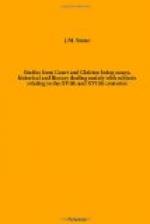Dr. Haigh further remarked that the scroll-work on the east side of the Bewcastle monument, and on the two sides of that at Ruthwell was identical in design, and differed very much from that which he found on other Saxon crosses. In fact, he knew of nothing like it, except small portions on a fragment of a cross in the York museum, on another fragment preserved in Yarrow Church, and on a cross at Hexham. There are, however, several other such stones which were unknown to Dr. Haigh, and engravings of them may be seen in Dr. John Stuart’s magnificent work on The Sculptured Stones of Scotland.
At Carew, in Pembrokeshire, runic crosses of the Saxon period without figures may be seen, and there is a runic cross at Lancaster with incised lines and a pattern in relief, supposed to be of the fifth or sixth century. The sculptured stones of Meigle in Scotland have no runes. Runes were, as it is well known, the characters used by the Teutonic tribes of northwest Europe before they received the Latin alphabet. They are divided into three principal classes, the Anglo-Saxon, the Germanic, and the Scandinavian, bearing the same relation to each other as do the different Greek alphabets. Their likeness to each other is so great that a common origin may be ascribed to all. They date from the dim twilight of paganism, but were for a time employed in the service of Christianity, when after being imported into this country where they were first used in pagan inscriptions cut into the surface of rocks, or on sticks for casting lots, or for divination, they were at last made to express Christian ideas on grave crosses or sacred vessels.
“In times,” says Kemble,* “when there was neither pen, ink, nor parchment the bark of trees and smooth surfaces of wood or soft stone were the usual depositaries of these symbols or runes—hence the name run-stafas, mysterious staves answering to the Buchstaben of the Germans.
* Archaeologia, vol. xxviii. On Anglo-Saxon Runes.
We may observe in passing, that the word Buchstaben, beech-staves, is a direct descendant of these wooden runes.
As early as 1695 antiquaries were busy with the Ruthwell Cross, but at the beginning of the nineteenth century profound ignorance still reigned in regard even to the language which the runes were intended to convey. Bishop Gibson, in his additions to Camden’s Britannia, described the cross vaguely as “a pillar curiously engraven with some inscription upon it.” In a second edition this reads, “with a Danish inscription.” Later it was thought to be Icelandic, and it was Haigh who first thought that Caedmon and no other was the author of the runic verses which he deciphered, considering that there was no one living at the period to which he assigned the monument, who could have composed such a poem but the first of all the English nation to express in verse the beginning of created things.
In 1840, Kemble published his Runes of the Anglo-Saxons, showing that the Ruthwell Cross was a Christian monument, and that the inscription was nothing less than twenty lines of a poem in Old Northumbrian or North English.




